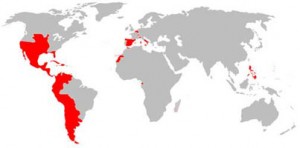In the context of the Carceral Archipelago project, my research addresses the circulation of convicts to and within colonial and post-colonial Latin America, in connection to other (“free” and “unfree”) labour flows and other types of punishment. The focus lies on convict transportation to colonial military fortifications (presidios) and post-colonial penal colonies, and the chronology covers the period from 1750 to 1958. During the first seven months of research, I have been especially mapping the presence of convict in, and the routes of their transportation to, the presidios in the Spanish empire during the second half of the 18th century. This brought me to areas as far from each other as peninsular Spain, North Africa, the Caribbean, California, Florida and Louisiana, South America (excluding Brazil), the Philippines, and the islands of Annobon and Fernando Po in Guinea.
No doubt, the geographical scope has become broader than Spanish America. I will not deny that my own curiosity plays a part in this “expansion”. However, there is much more about it. For example, the circulation of convicts and military convicts from peninsular Spain to the Caribbean – the single most important route from a quantitative point of view – cannot be explained unless the circulation from the North African presidios to peninsular Spain is taken into account. But there is also another reason, which has kept fascinating me since I started this research: Spanish “America” actually included parts of Asia, Oceania, and Africa.
The Viceroyalty of New Spain included, among others, present-day Mexico, Central America (except Panama), Cuba, Puerto Rico, most of the United States west of the Mississipi River, and Florida. However, the Philippines in Asia, and the Micronesian territories of the Marianas and the Caroline Islands in Oceania were also administratively dependent on the Viceroy based in Mexico City. In addition to this, when under the Treaty of El Pardo (1778) the Portuguese crown ceded the islands of Fernando Poo and Annobon in Guinea to the King of Spain, these territories were officially put under the jurisdiction of the Viceroy of the Rio de la Plata, based in Buenos Aires. The sources held at the Archivo General de Indias in Sevilla and at the Archivo Historico Nactional in Madrid actually reveal that the expedition that settled the islands sailed from the present-day-Argentinean capital. To make things even more interesting (or complicated), if the annexation would have happened only a couple of years earlier, the Guinean islands would have administratively depended on the Viceroyalty of Peru, since the Viceroyalty of the Rio de la Plata was only established in 1776 as a partition of the former.
What then if – to put it very simply – the Philippines and Guinea belong to America (and an America called “Indias”)? In my opinion, this forces us, as historians, to avoid superposing our own contemporary spatial categories to the past realities we study; conversely, it requires that we “listen” to what the sources are actually telling us (and to their silences too) about space and its perception. For otherwise not only would we not understand why the records on Fernando Poo are included in a record that also inform us about new routes from Buenos Aires to Potosi, and on the new settlements in the Falklands/Malvinas and along the Patagonian coast. We would not be able to find those records, and even less so to interpret them. On the contrary, if we reflect on the picture the records are providing us with, a whole set of questions guides our exploration: how did officials in Buenos Aires think about Guinea? How did officials in Mexico City perceive the Philippines, or the Mariana Islands? And how different were their perceptions from those of other inhabitants of those two viceroyal capitals? And from those of the Spaniards living in, and the native populations of, the Philippines?
An important point, then, is to realize how contemporaries understood the spaces that we are trying to address. This reminds me of a series of highly interdisciplinary, volumes that have been published in the last decade on the “perception of the world in pre-modern societies” (Talbert and Brodersen, 2004; Raaflaub and Talbert 2010; Geus and Rathmann 2013). And the fact that those volumes mostly focus on the ancient world, i.e. before the formation of a unified world-system, makes me think that the very concept of “the global” ought not necessarily be conflated with a planetary perspective. For what matters is to understand the actors’ own representation, and to follow the specific traces they have left (and, indeed, reflect on those traces that the archive-makers have more or less consciously eliminated). Which is possibly what we mean by “global history” in the Carceral Archipelago project, and certainly the way I see it: not a forcibly planetary perspective, but the mapping of specific connections and circulations, the awareness of the importance of (geographical and represented) space in history, the sensibility for the complex interactions and the power inequalities that exist in each context we deal with. “Following the convicts”, then, and their ideas and practices, and the ideas and practices about them, as one significant way to understand the complexity of past (and present?) societies.
References:
R.J.A. Talbert, and K. Brodersen, Space in the Roman World: its Perception and Presentation. Münster: LIT Verlag, 2004
K.A. Raaflaub, R.J.A. Talbert, Geography and Ethnography: Perceptions of the World in Pre-Modern Societies. Bognor Regis: Wiley-Blackwell, 2010
K. Geus, and M. Rathmann, eds, Vermessung der Oikumene. Berlin and Boston: Walter de Gruyter, 2013



 Subscribe to Christian De Vito's posts
Subscribe to Christian De Vito's posts
Recent Comments